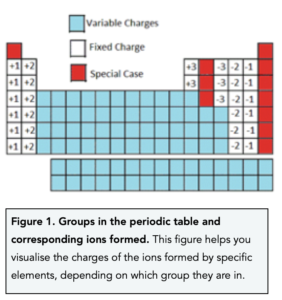Electron Transfer & Ions (GCSE Chemistry)
Electron Transfer & Ions
Ionic Bonding
Definitions
An ionic bond is the bond formed between positively charged and negatively charged ions (oppositely charged ions) due to the electrostatic forces of attraction between them.
A giant 3-D lattice is the name of the structure formed from ionic bonding. This is described further on.
Formation of Ionic Bonds
So how do we form an ionic compound such as sodium chloride (NaCl)?
Let us take an atom of sodium (Na) and an atom of chlorine (Cl):
- We begin with Na and Cl atoms. Na (metal) and Cl (non-metal) both want to have a full outer shell/ Sodium prefers to form an Na+ ion (lose one electron) and chlorine prefers to form a Cl- ion (gain an electron).
- There is electron transfer from metal to non-metal. An electron can be transferred from one Na atom to one Cl atom. This forms Na+ and Cl–, which both have a full outer shell like the noble gasses.
- NaCl forms a compound. There is an electrostatic attraction between Na+ and Cl– ions holding them together. The overall charge of the compound is neutral, but it consists of charged ions.
- NaCl is a giant lattice. NaCl actually has a structure of a giant lattice of oppositely charged ions, which are held together by strong electrostatic attractions acting in all directions, between the Na+ and Cl– ions. The ions are arranged in an alternating pattern.
Transfer of Electrons
The atoms in an ionic bond achieve a full outer shell when they form ions and become more stable like the noble gases.
- Ions are formed due to transfer or electrons. Ions are formed from atoms when electrons are transferred between them. A negative ion is formed if an atom gains an electron and a positive ion is formed if an atom loses an electron.
- Atoms form ions to gain a full outer shell of electrons. Atoms want to gain a full outer shell of electrons because this makes the atoms stable and unreactive like the noble gases which are inert.
Finding the Charge of Ions
- Different elements have different numbers of outer electrons. The group of the periodic table the element is in tells you how many outer shell electrons it has. For example, Group 1 elements have one electron in their outer shell, Group 2 elements have two electrons in their outer shell, and so on.
- We can predict ions using the Periodic Table. We can predict the charge on a simple ion using the group number of the element. For example, all Group 1 elements have 1 outer electron, so will each lose 1 electron to form a 1+ ion with a full outer shell. All Group 6 elements will gain 2 electrons to form a 2– ion with a full outer shell.






Still got a question? Leave a comment
Leave a comment